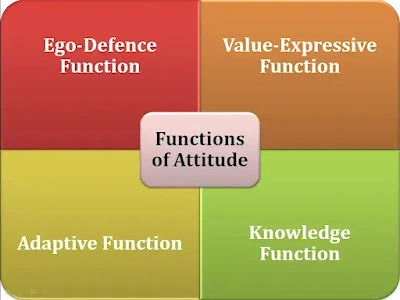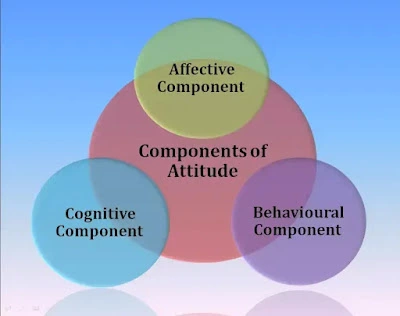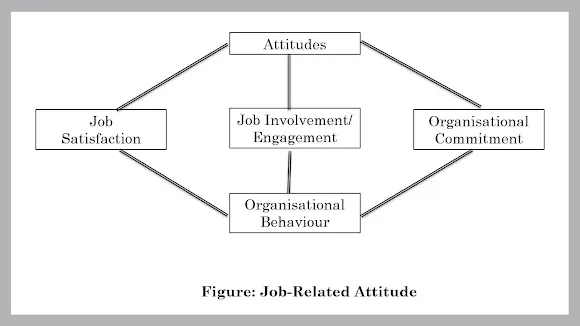Table Of Content:-
- Attitude Meaning
- Attitude Definition
- Types of Attitude
- Nature of Attitude
- Features of Attitude
- Characteristics of Attitude
- Components of Attitude
- Functions of Attitude
Attitude Meaning
Attitude is the state of mind of a person towards something. It may be defined as a negative or positive evaluation of an object that affects a human’s behaviour towards an object, people, or event. Attitudes, especially individual attitudes, have a key bearing on how individuals function within the organization, particularly as these attitudes may be reflected in positive or negative behaviour.
Attitude is a mental state of readiness. An attitude is a readiness to respond coherently to certain institutions, persons, or objects. Attitude depends on feelings, disposition, manners, and position, especially on a person’s point of view, tendency, or orientation. What has been learned has become a specific mode of response.
Related Article:- Types of Motivation
Attitudes are an individual’s predispositions towards given aspects of the world. For example, as a manager, if one wants to manage efficiently then one is expected to know in advance the attitude of the subordinates and workers because attitude does influence the behaviour of people and also their performance. Attitude puts a person ready to respond favourably or unfavourably to actions and situations in the environment.
Attitude Definition
Budworth states– “Attitudes are somewhat permanent tendencies of the object of interest, consisting in the anticipation of some kind of forethought and readiness for due process.”
According to Reimers and Gage – “Attitude is that emotional tendency organized by experiences, which responded positively or negatively to a psychological substance or object.”
Related Article: Transactional Analysis in Organisational Behaviour
According to Cratch and Cratchfield – “Attitude can be defined as the permanent organisation of a person’s motivational, emotional, perceptual and cognitive responses to some part of the world.”
Frank Freeman said, “An attitude is a dispositional readiness to respond to certain institutions, persons or objects in a consistent manner which has been learned and has become one’s typical mode of response.”
According to N.L. Munn, “Attitudes are learned predispositions towards aspects of our environment. They may be positively or negatively directed towards certain people, services, or institutions”.
Kay Trill states – “Attitude is a state of permanent readiness, more or less, of a mental organization that enables a person to respond in a targeted way to an object or to a situation to which he relates.”
Definition of Attitude
Thus, ‘attitude’ expresses favourable or unfavourable thoughts and feelings towards a psychological substance- person, thing, institution, religion, idea, etc. The object or person towards which there is a mental suggestion, as are the feelings, the same behaviour shows favourable or unfavourable. This display of favourable or unfavourable behaviour expresses a liking or dislike for that stimulus.
According to Bitt: “Attitude is a state of vascular and mental readiness, which has a directional or dynamic effect on the response to all objects and situations related to the individual.”
Attitude is a mental inclination that is related to the mental attitude of behaviour in social situations. This instinct refers to the decision of a human being through which he displays a particular type of behaviour towards some object or situation or expresses thoughts;
For example, our belief in any religion or any political party, etc. Attitude is also influenced by friends, neighbourhood, society, school, newspapers, magazines, media, etc., and keeps changing according to the time and situation.
Sometimes attitudes may be affected by the organisation itself, and one of the challenges facing the modern manager may be how to affect an attitude change in the organisation within the broad reference of cultural or strategic change.
Types of Attitude
There are three types of attitudes
- Positive attitude,
- Negative attitude and
- Neutral attitude.
These three types of attitudes are explained as follows:-
1. Positive Attitude
A positive attitude means how positive a person thinks. With positive thinking, a person can bring positive change in his life. A positive attitude organizes a person’s behaviour as it keeps his work moving & progressing, which means maintaining an optimistic viewpoint gives many benefits in any situation. The best way to have a positive mindset is to avoid negativity and believe in yourself with a list of attitudes such as confidence, sincerity, happiness, and determination.
Positive attitude traits are as follows:
- Sense of responsibility
- Optimism
- Cheerfulness/Happiness
- Tolerance
- Determination
- Sincerity
- Flexibility
- Humility
- Reliability
- Confidence
- Diligence
2. Negative Attitude
A negative attitude is a temperament, feeling, or manner that is not cooperative, constructive, or optimistic. It can affect anyone and anywhere. A negative attitude badly affects a person’s mindset, which forms anger, doubt, and frustration. Human behaviour like this will affect a person’s career. Anger is a type of negative attitude which is a primary cause of self-destruction that leads to devastation because anger doesn’t allow our brain to think thoroughly for better solutions; instead, it makes the situation complex. A positive attitude is an important characteristic for achieving success in life.
A negative attitude is harmful mainly; due to it, there is a hindrance in the formation of many relationships, and there is a possibility that the maintained relationships can get spoiled. On the other hand, we may lose many good opportunities in our lives due to our negative thinking. Socialism plays a significant role in human life. Confidence is essential in social life. So, our positive attitude connects us with society, and we can get isolated from society due to a negative attitude.
Negative attitude traits are as follows:
- Anger
- Jealousy
- Hatred
- Doubt
- Inferiority
- Frustration
- Pessimism
- Resentment
3. Neutral Attitude
In this type of attitude, everything is neutral, as there is no hope and doubt; people usually become lazy and unemotional. They don’t care much for anything; they go with the flow. People with a neutral attitude don’t give sufficient importance to events or situations. They generally ignore the problems and leave them for someone else to solve.
Neutral attitude traits include:
- Complacence
- Detachment
- Indifference
- Unemotional
- A feeling of being disconnected
Nature of Attitude
The nature of attitude is given as follows:
1. An individual’s attitude is an overall combination of his characteristics such as beliefs, personality, values, behaviours, and motivations.
2. An attitude is a part of an individual’s mindset. It helps them to define their identity, guide their actions, and judge people.
3. Attitudes are learned behaviours it is not inborn talents rather they can be developed through learning and experiences.
4. Attitudes are not static they can be changed according to the moods, situations and knowledge of the individual, they evolve with age and the experiences an individual has in life.
5. While emotions or beliefs are internal characteristics of individual behaviour, still we can see them through an individual’s behaviour or personality that results from his attitude.
6. Attitude is the cause of an individual behaviour it defines how people perceive or respond to objects or situations around them.
7. Attitude is the basis of internal cognitions or beliefs and thoughts about people and objects.
8. An individual’s experiences, upbringing, and social interactions influence the formation of individual beliefs which later becomes the basis of overall attitude.
Features of Attitude
Features of attitude include the following points:
1) Attitudes have an Object
Attitudes must have an object. They must have a focal point, whether a theoretical concept, such as “ethical behaviour,” or an actual item like a car. The object can be a physical thing, such as an article, or an action like buying a mobile phone. In addition, the object can be either an object, such as a person, or a collection of items, such as a social group.
2) Attitude own Direction, Degree, and Intensity
An attitude expresses how a person feels toward something. It expresses:
- Direction: An individual is either favourable or unfavourable towards an object;
- Degree: How much a person likes or dislikes the object; and
- Intensity: The sureness or confidence in expressing something or how fully a person feels about his opinion. Although degree and intensity may seem the same and related, they are not synonymous.
3) Attitudes have a Structure
Attitudes demonstrate an organisation, which means they possess inter-attitudinal centrality and have internal consistency. They also tend to be stable, to have varying degrees of silence, and to be generalised. The structure of human attitudes may be viewed as a complicated ‘Tinker Toy’, set fabricated in a type of circular pattern.
At the centre of this arrangement are somebody’s significant values and self-concept. Attitudes connected to the centre of this system are said to have a high level of centrality. Other attitudes located further out in the structure hold less centrality.
4) Attitudes are Learned
Attitudes are gradually learned over time. The learning process of attitudes starts in childhood and continues all over the life of a person. However, in the beginning, the family members significantly impact a child’s attitudes.
For example, suppose the family members have a positive attitude toward business and a negative attitude towards service. In that case, there is a greater likelihood that the child will teach similar attitudes towards these objects.
 Characteristics of Attitude
Characteristics of Attitude
The characteristics of Attitude are as follows:
- Attitude is an object
- Attitudes are learned
- Attitudes are predispositions
- Attitudes are relatively stable phenomena
- Attitude has an emotional component
- Attitudes influence human behaviour
 Characteristics of Attitude are explained as follows:
Characteristics of Attitude are explained as follows:
1. Attitude has an object
An attitude is an object liked or disliked, favoured or disfavored, or evaluated as negative or positive. The object can be an idea, a thing, a person, or a situation.
2. Attitudes are learned
A person learns attitude. It is not an inborn phenomenon. Attitudes are learned through experiences and social interactions. We interact with others, experience many things and acquire information about things, leading to negative or positive attitudes towards different things.
3. Attitudes are predispositions
An attitude is a predisposition – a prior determined or learnt view of a thing or tendency to act in a specific way towards a thing. A person has a view which is already formed in his mind.
4. Attitudes are relatively stable phenomena
An attitude is not a momentary feeling but a long-held thought of something. Though attitudes can be changed occasionally, it is a relatively stable phenomenon that persists for some time.
5. Attitude has an emotional component
It has an emotional aspect of liking or disliking an object.
6. Attitudes influence human behaviour
A positive attitude towards something will affect human behaviour towards the thing favourably. Similarly, a negative attitude affects human behaviour towards a thing unfavourably. For example, a vegetarian would avoid eating chicken due to his negative attitude towards chicken consumption.
Components of Attitude
An attitude comprises of following components:
1) Cognitive Component
The cognitive component of an attitude is a person’s factual knowledge of the situation, object, or person, including oneself. In other words, the cognitive component leads to how much somebody knows about a topic.
For example, The cognitive component of computer concern would be based on how much a person knows about computers and his level of understanding of computer work.
2) Affective Component
The affective component of attitude consists of a person’s evaluation, liking, or emotional response to some object, situation, or person. Affective responses reflect one’s attitude with sensations of happiness, sadness, or other levels of physical arousal.
For example, For the attitude construct of laptop anxiety, a topic of current interest, the affective component would be a personal liking for the laptop and his feeling of excitement, or fear, when he used one.
3) Behavioural Component
The behavioural component of an attitude involves the person’s apparent behaviour directed towards an object, situation, or person.
For example, the behavioural component of computer concern would be related to how often a person has used a computer and what kind of experience he has had.
For example, people who routinely use machines, especially if they choose to use them freely, are more likely to have positive attitudes toward machines and be less anxious than others with less experience with machines.
The components are not isolated but are interrelated and represent the attitude construct. Organising framework or mental.
Functions of Attitude
According to Katz, the functions of attitude fall into the following categories:
1) Adaptive Function
Some attitudes assist in enabling oneself to attain particular, desired goals or avoid unwanted situations. The holding and representing of certain attitudes may bring about direct rewards.
Alternately, some attitudes allow a person to access circumstances where rewards are available, such as when expressing a liking for particular music or ways of dressing; some adolescents can join appropriate social groups and receive the advantages of group membership (social support, friendship, and so on). Moreover, expressing other attitudes may help some people avoid negative situations.
For example, In an election, generally, the people from the minority cast votes for those candidates who promise to keep reservations.
Meanwhile, the people generally vote for those who promise to remove the reservation system. Thus, the voting behaviour of both groups is influenced by the utility and interest served.
2) Knowledge Function
Some attitudes are beneficial as they help us to understand the world more clearly. They help people ascribe causes to events and direct attention towards features of people or situations likely to help make sense of them. As a result, they help make the world more understandable, anticipated, and prominent and increase the efficiency of knowledge processing (cognitive economy).
For example – Stereotyping. Stereotypes are mental structures that allow us to predict a person’s features based on the group they belong to.
For example, Somebody interested in hi-fi systems is likely to read magazines about them, visit exhibitions, and discuss them with friends to know the latest products.
 3) Value-Expressive Function
3) Value-Expressive Function
Some attitudes are essential to a person because they express values that are basic to that person’s self-concept (i.e., their ideas about who they are). Consequently, attitude is a part of who they are, and the expression of attitude says essential points about the person to others.
For example- A profoundly religious person will feel that his identity is being actualised if he holds political views that reflect her religiosity, such as support for prayer in school.
Attitudes that serve a value-expressive function are not very likely to change because they are grounded in an individual’s concept of self. Attitude change will come about if a person’s self-concept changes.
4) Ego-Defence Function
This attitude function protects people from accepting the bitter and honest truth about themselves. It helps a person during his emotional conflict situations. The ego defence function is also used to define the ego and self-respect of a person.
Thus, this function includes different defence mechanisms (rationalization, denial, repression, etc) used by an individual to protect himself from psychological harm. Generally, the ego defensive function is used by an individual when he is frustrated and wants to satisfy his ego.
Related Article:- Nature of Organisational Behaviour
For example – One way children might defend themselves against the humiliation they have experienced in P.T. lessons is to adopt a strongly negative attitude toward all sports. People whose pride has suffered by allowing a defeat in sport might similarly adopt a defensive attitude. This function has psychiatric overtones.
Positive attitudes towards ourselves have a protective function (i.e., an ego-defensive role) in helping us preserve our self-image.
Job-related Attitude
OB focus on employees’ job-related attitudes. These attitudes have positive or negative imaginations that employees hold about certain aspects of their work environment. Behavioural scientists have given the primary focus on three job-related attitudes, as shown in the figure:
2) Job Involvement
3) Organisational Commitment
4) Organisational Behaviour
You May Also Like:-
Nature of Organisational Behaviour
Conceptual Foundation of Organisational Behaviour
Contributing Disciplines to organisational behaviour
Models of Organisational Behaviour
Approaches of Organisational Behaviour
Emotional Intelligence in Organisational behaviour
Factors Influencing Perception
Scope of Organisational Behaviour
Importance of Organisational Behaviour
Challenges and Opportunities of Organisational Behaviour
Factors affecting group behaviour
Causes of Conflict in an Organisation
Types of Conflict in an Organisation
Organisational Development Process
Factors Affecting Organisational Culture
Trait Theory: Stogdill’s trait factors


 1)
1) 